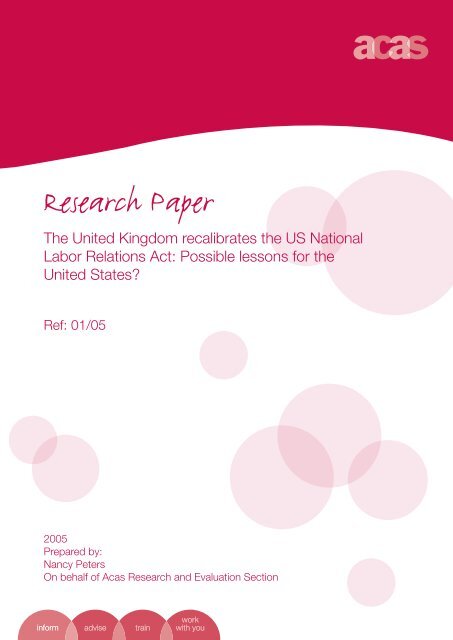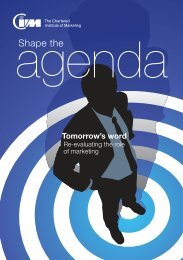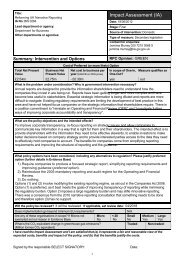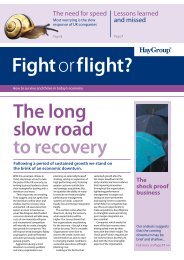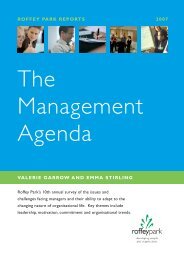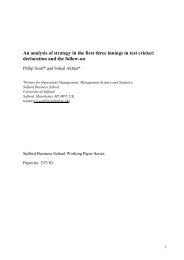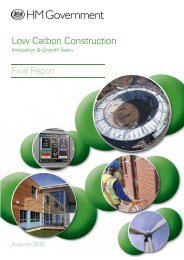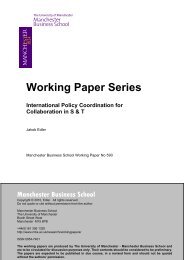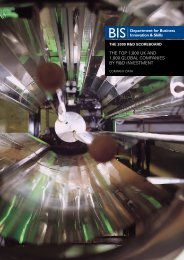Research Paper - Management and Business Studies Portal
Research Paper - Management and Business Studies Portal
Research Paper - Management and Business Studies Portal
Create successful ePaper yourself
Turn your PDF publications into a flip-book with our unique Google optimized e-Paper software.
<strong>Research</strong> <strong>Paper</strong>The United Kingdom recalibrates the US NationalLabor Relations Act: Possible lessons for theUnited States?Ref: 01/052005Prepared by:Nancy PetersOn behalf of Acas <strong>Research</strong> <strong>and</strong> Evaluation Section
For any futher information on this study, or other aspects of the Acas<strong>Research</strong> <strong>and</strong> Evaluation programme, please telephone 020 7210 3926or email research@acas.org.ukAcas research publications can be found athttp://www.acas.org.uk/index.aspx?articleid=405ISBN 0 9552187 1 3ISBN 978 0 9552187 1 2
PreambleThe research set out in this Acas <strong>Research</strong> Report was carried out by Nancy Peters, alawyer <strong>and</strong> accountant based in Washington, D.C. This paper is the product of aproject sponsored by the UK Foreign <strong>and</strong> Commonwealth Office under the AtlanticFellowships in Public Policy. During 2002 <strong>and</strong> 2003 Nancy spent 10 months as avisiting scholar, working in Acas’ <strong>Research</strong> <strong>and</strong> Evaluation Section. This paper has alsobeen published under the same title in Comparative Labor Law <strong>and</strong> Policy Journal(Volume 25, Number 2, winter 2004). We are grateful to Nancy <strong>and</strong> to the journalpublishers for the opportunity to re-publish the paper as an Acas <strong>Research</strong> Report. Thereport reflects the views of the author alone, <strong>and</strong> not those of the Acas Council.The paper compares the new UK recognition procedures set up under the EmploymentRelations Act 1999 with procedures available under the US National Labor RelationsAct, <strong>and</strong> examines the extent to which the new UK statutory provisions may haveimproved the operation of the NLRA recognition model. It concludes with severalrecommendations for further reform, based on assessment of the operation of UKscheme in its first three years.
Contents1. Introduction ............................................................................................... 32. Background ................................................................................................ 33. United Kingdom Statutory Recognition Scheme Similar to that in theUnited States .............................................................................................. 43.1 Basic Statutory Schemes ................................................................................ 53.2 Significant Variations in Specific United Kingdom <strong>and</strong> United States RecognitionProcedures ................................................................................................. 54. Disparate Outcomes for U.K. <strong>and</strong> U.S. Recognition Schemes ...................... 74.1. U.S. Recognition Results From Government-Monitored Elections......................... 74.2 Vast Majority of U.K. Recognition Deals are Voluntary ....................................... 84.3 Most M<strong>and</strong>atory U.K. Recognition Deals Led to Productive Contract Negotiations .. 85. U.K. Innovations Add Incentives for Productive Negotiation .................... 125.1 Voluntarism Written into the U.K. Statutory Scheme .........................................125.2 Minimum Negotiation St<strong>and</strong>ards Set by Statutory Bargaining Procedures Model....136. Conclusion ................................................................................................ 16Annex I Comparison of U.K. <strong>and</strong> U.S. Statutory Recognition Schemes .......................17Annex II Survey Responses ..................................................................................20
1. IntroductionSince June 2000, the United Kingdom has administered a statutory scheme for tradeunion recognition similar to that available under the U.S. National Labor Relations Act(NLRA), by which a majority of workers may dem<strong>and</strong> that their employer recognize aunion as their bargaining representative in collective bargaining over pay <strong>and</strong> workingconditions. However, the new U.K. recognition procedures, set up under theEmployment Relations Act 1999, include innovative features such as a statutoryprototype of bargaining procedures <strong>and</strong> various other provisions that encourageunions <strong>and</strong> employers to settle their differences voluntarily, rather than throughadministrative <strong>and</strong> judicial litigation. Historically, U.S. recognition procedures underthe NLRA have been characterized by conflict <strong>and</strong> protracted litigation, <strong>and</strong>, in manycases, newly recognized union representatives fail to negotiate any terms <strong>and</strong>conditions of work (a so-called “first contract”) for their workers. This study comparesU.S. <strong>and</strong> U.K. recognition practices, examining to what extent the new U.K. statutoryprovisions may have improved the operation of the NLRA (or more broadly speaking,the North American) recognition model.2. BackgroundThe recognition process - how a union gains an official place at the bargaining table -varies widely among different countries. One very sharp contrast, though, is thatbetween those procedures used in the United States <strong>and</strong> Canada (the “North Americanmodel”) <strong>and</strong> the general process in countries such as Germany, Belgium, <strong>and</strong> Italy(the “European model”). On the one h<strong>and</strong>, the European model organizes workers at anational level, with industry-wide bargaining for wage rates <strong>and</strong> working conditions. Inthis model, recognition by individual employees is more or less routine, <strong>and</strong> there isgenerally no legal statute that states that employers have a duty to bargain withunions. For the most part, the entire recognition process is considered voluntary.The North American model, on the other h<strong>and</strong>, is almost precisely the opposite.Bargaining is most often done at the smallest local unit, <strong>and</strong> every aspect ofrecognition is governed by statutory, administrative, <strong>and</strong> judicial requirements. Mostgenerally, the model says that if a majority of workers - as certified by a governmentagency - want union representation, then the employer must recognize the union: thisis so-called “m<strong>and</strong>atory recognition.” Table 1 sets forth major differences in the tworecognition models.3
Table 1: Generalized Characteristics of North American <strong>and</strong> European RecognitionModels iAmerican Recognition ModelEuropean Recognition ModelMajority of workers in an individual workplacemay choose (by secret ballot) their unionrepresentative.Centralized industry groups select a unionrepresentative for industry workers.Statute provides a statutory duty to recognizeunion.M<strong>and</strong>atory recognition is the rule.No statutory duty to recognize union.Voluntary recognition is the rule.Disputes resolved through legal <strong>and</strong>administrative processes.Disputes resolved through voluntary action byemployers <strong>and</strong> unions.For the past thirty years or so, union recognition in the United Kingdom has beensomewhere in the middle of these two models. After a long tradition of mostlycentralized industry bargaining with voluntary non-legalistic recognition procedures, itmoved toward decentralized workplace bargaining with legally regulated procedures.In the 1970s, there were two attempts to provide unions with a right to recognition,both of which had been repealed by 1980. ii Then, in 1999, with the enactment of theEmployment Relations Act, the United Kingdom set up a system that firmly plants U.K.collective bargaining with the North American model.Ironically, while the United Kingdom has steered ever closer to the North Americanmodel in the past thirty years, during the same period, the U.S. recognition processhas been increasingly mired in hostility <strong>and</strong> protracted delay. In fact, the major laborissues in the United States today revolve around the recognition process: that is, forthe most part, when union representation is established in the workplace, collectivebargaining runs generally rather smoothly, with relatively small numbers of industrialactions <strong>and</strong> strikes in recent years. The recognition process, though, has nearlybroken down with constant litigation <strong>and</strong> persistent delays. Over the period from 1960to 1989, the time it took to determine whether workers wanted union representation(essentially the union election) increased fourfold from an average of 54 days per caseto 212 days per case. iii But in addition to such protracted delays, there is also thelikelihood that once recognition has been required, there will never be a collectiveagreement because of continuing hostility between the union <strong>and</strong> the employer.3. United Kingdom Statutory Recognition Scheme Similar to that in theUnited StatesWhen one compares the statutory schemes for recognition set up under theEmployment Relations Act 1999 <strong>and</strong> the NLRA (the prototype for the North Americanrecognition model), initially one is struck by the similarities in the two schemes. Bothcountries, for example, have put the responsibility for managing the process in anindependent government agency. In the United Kingdom, it is the Central ArbitrationCommittee (CAC) <strong>and</strong> in the United States, it is the National Labor Relations Board(NLRB). However, while the general outline of the recognition process is remarkablysimilar, the details of the operation of the process can be very different.4
3.1 Basic Statutory SchemesIn the United States, the NLRA (<strong>and</strong> related judicial <strong>and</strong> administrative rulings) setforth the basic procedures for statutory recognition, i.e., where the employer has notvoluntarily recognized the union as bargaining representative. Initially, workers in an“appropriate unit” may petition an independent government agency - the NLRB - torequest an election. The NLRB establishes that the workers are in an appropriate unit(a “bargaining unit”) where workers share a “community of interests.” If the union canshow that 30 per cent of the unit supports union representation, the NLRB can orderan election, a secret ballot to be held on the employer’s premises. If a majoritypercent of the workers voting in the election agree to the specific trade union as arepresentative, then the NLRB certifies the election result <strong>and</strong> the employer mustrecognize the union. Once the union is certified, the employer has a “duty to bargain”with that union as the workers’ elected representative.In the United Kingdom, the general statutory structure in the Employment RelationsAct 1999 mirrors that of the United States. To obtain statutory recognition, a tradeunion applies to an independent government agency - the CAC. iv Similar to its U.S.counterpart, the CAC may approve or impose an appropriate bargaining unit <strong>and</strong>,upon a showing of worker support for trade union representation, may order anelection. If a majority of workers support trade union representation, the CAC will thendeclare that the trade union must be recognized by the employer. The simplifiedstages of the basic statutory scheme - which can be described generally as the NorthAmerican recognition model - are set forth in Table 2.Table 2: American Model for Statutory RecognitionStage 1 Stage 2 Stage 3 Stage 4Union applies forstatutoryrecognition withgovernmentagency.Appropriatebargaining unit forrepresentation isdetermined.Governmentagency ordersm<strong>and</strong>atoryrecognition if aconsensus ofworkers wantsrepresentation.Employer <strong>and</strong> unionrepresentativenegotiate asubstantiveagreement.3.2 Variations in Specific United Kingdom <strong>and</strong> United States RecognitionProceduresIn the details of the recognition process, the United Kingdom <strong>and</strong> United States’procedures differ significantly. The variations reflect different political compromises aswell as the varied cultural traditions of the two countries. Table 3 lists some significantprocedural differences in the two processes. vAnnex I further summarizes major statutory variations between the United Kingdom<strong>and</strong> the United States.5
Table 3: Some Significant Differences in U.K. <strong>and</strong> U.S. Recognition SchemesGeneral statutoryelement for NorthAmerican recognitionmodelNecessary worker supportfor recognitionUnion rightsTime limits before unioncan re-applyTime limits beforeemployer can challenge theunion majorityRequired subjects forbargainingEmployer bargainingrequirementsU.K. procedureTo apply, over 50 per centof unit must be likely tosupport; to win, 40 percent of entire unit mustvote for union.Election may beunnecessary if a majorityof the unit are unionmembers; if in anelection, the union has aright of access to workers.3 years 1 yearU.S. procedureTo apply, over 30 per centmust show an interest; to win,over 50 per cent of thosevoting must vote for union.No comparable provisions inU.S. law.3 years 1 year if no collectivebargaining agreement; up to 3years if there is an agreementfor that term.Only pay, hours <strong>and</strong>holidays required.No duty to bargain, butdetailed statutory modelfor bargaining procedures.Only “m<strong>and</strong>atory” subjectsrequired.Duty to bargain but fewspecific statutoryrequirements.Voluntary options Strongly suggested. None suggested.The different political compromises between the rights of workers <strong>and</strong> unions on theone h<strong>and</strong>, <strong>and</strong> those of employers on the other h<strong>and</strong>, can be seen in the implicationsof the first two categories, categories labeled “necessary worker support” <strong>and</strong> “unionrights.” The first category concerns how much support a union must demonstrate inorder to (1) apply for recognition, <strong>and</strong> (2) win m<strong>and</strong>atory recognition. In fact, theUnited Kingdom has higher thresholds of worker support than the United States.However, if one looks at the second category, “union rights,” one sees that while theUnited Kingdom may require a higher proportion of worker support, it also providesmore union rights once such support is demonstrated. Importantly, once U.K. unionshave demonstrated the necessary support from workers of the bargaining unit, <strong>and</strong> ifa majority of the worker are holders of a union membership, formal electionproceedings may not be required (in the United States, this is the so-called “cardcheck”recognition).The time limits are telling as well. In the United Kingdom, a union can be barred fromreapplying after an unsuccessful recognition attempt for a longer period of time (threeyears) than a union in the United States (one year). However, the union majority isalso protected for a longer period of time (three years) from subsequent employerchallenge.6
One of the more controversial items in the United Kingdom scheme was the decisionto limit the bargaining subjects that an employer may be required to negotiate tothree: pay, hours, <strong>and</strong> holidays. By contrast, the United States does not expresslylimit the topics, but required bargaining is limited only to “m<strong>and</strong>atory” subjects,namely those subjects that directly affect the “terms <strong>and</strong> conditions of work.”One major difference in the United Kingdom <strong>and</strong> the United States schemes relates tohow the employer must conduct negotiations after statutory recognition. In the UnitedStates, the employer has a non-specific “duty to bargain”, an ill-defined term thatrequires only that the employer bargain in “good faith” at “reasonable” times. In theUnited Kingdom, on the other h<strong>and</strong>, the employer <strong>and</strong> union must agree on a methodof how to conduct collective bargaining within thirty days of recognition, or either sidemay call upon the CAC to impose a statutory method of bargaining. The statutorymethod is a lengthy set of very detailed procedures: e.g., there must be three union<strong>and</strong> three management representatives, with the head of the negotiating bodyalternating between union <strong>and</strong> management representatives.Another important difference between the two schemes is that the United Kingdomprovides both statutory <strong>and</strong> technical encouragement for voluntary recognition, thatis, opting out of the statutory CAC process altogether for a separate voluntaryagreement. Thus, for example, the U.K. statute requires that the union send a letterto the employer asking for voluntary agreement at least ten days in advance ofapplication for recognition. Should the employer want a voluntary agreement, there isan additional 20-day period set aside for the negotiations on voluntary recognition. Inaddition, though, another independent agency - the Advisory, Conciliation <strong>and</strong>Arbitration Service (Acas) - is available to assist the parties in informally determiningthe level of worker support for the union. There are no comparable procedures in theUnited States.4. Disparate Outcomes for U.K. <strong>and</strong> U.S. Recognition SchemesDespite major similarities in the statutory process, the U.K. <strong>and</strong> U.S. recognitionschemes show wide differences in outcomes. In the United States, recognition ispredominantly “m<strong>and</strong>atory” through government-supervised elections, <strong>and</strong> anestimated one-third of newly-recognized unions fail to reach a collective agreementwith their employers. In sharp contrast, the vast majority (94 per cent or more) ofU.K. recognition deals set up between 2000 <strong>and</strong> 2002 were voluntarily agreed upon bythe union <strong>and</strong> the employer, with no government supervision. vi Moreover, furtherreview of the small fraction of U.K. deals that were government-imposed showed thatmost m<strong>and</strong>atory cases resulted in productive successful collective negotiations, withonly a small number of cases likely to fail to achieve collective agreements onsubstantive issues.4.1. U.S. Recognition Results From Government-Monitored ElectionsIn 2001, unions won 1,274 NLRB elections. vii Once a U.S. union is recognized in anNLRB-certified election, the st<strong>and</strong>ard procedure is to try to negotiate a “first contract.”Whereas the United Kingdom has a two-stage negotiating process - where the union<strong>and</strong> the employer first agree on negotiating procedures (typically how bargaining willbe conducted, what issues will be negotiated, <strong>and</strong> how disputes will be h<strong>and</strong>led), <strong>and</strong>later conduct “rounds” of negotiation on pay <strong>and</strong> working conditions - U.S. unions7
generally negotiate both procedural <strong>and</strong> substantive issues at one time for onecontract. The Commission on the Future of Worker-<strong>Management</strong> (commonly referredto as the “Dunlop Commission”) viii estimated in 1994 that “on the order” of one-thirdof newly elected unions fail to negotiate a first contract. The U.S. Federal MediationConciliation Service developed this estimate from data it collected on first contractsbetween 1986 <strong>and</strong> 1993. ix Thus, using this estimate, about 425 of the 1,274 U.S.union representatives newly elected in 2001 will likely fail to reach any collectiveagreement on working conditions.4.2 Vast Majority of U.K. Recognition Deals are VoluntaryAlthough there is no official government count of U.K. recognition deals, the TradesUnion Congress (TUC) collects data on recognition deals completed by its memberunions, presented in its annual report Focus on Recognition. x The TUC reported 470new recognition deals in 2001 <strong>and</strong> 306 in 2002. xi As can be seen in Table 4, by far thevast majority of the recognition deals reported by the TUC were voluntaryagreements. During the two-year period, November 2000 through October 2002, theCAC imposed forty-four recognition agreements. Thus, approximately 6 per cent of thetotal 776 agreements were m<strong>and</strong>atory, leaving 94 per cent concluded voluntarilybetween the unions <strong>and</strong> employers. xiiTable 4: Data on Recognition Deals November 2000 through October 2002Type of recognition dealM<strong>and</strong>atory: those deals that completedthe CAC statutory processVoluntary: those deals that either did notstart or did not finish the statutoryprocessNumber of TUC cases44 (6 per cent)732 (94 per cent)Total deals 776Most of the recognition deals reported by the TUC were likely to have been concludedwithout any formal application to the CAC. In a 2003 report, the U.K. Department ofTrade <strong>and</strong> Industry reported on the cases the CAC dealt with in the first two years ofits operations (June 2000 through May 2002). xiii In this period, the CAC received about165 different cases (it actually received 188 applications but at least twenty-threewere withdrawn <strong>and</strong> resubmitted at a later date) or roughly eight cases per year. Ofthese, about one-quarter resulted in statutory recognition, about one-quarter optedout of the formal CAC process for voluntary recognition, <strong>and</strong> the remaining were eitherwithdrawn without recognition or a union lost an election.4.3 Most M<strong>and</strong>atory U.K. Recognition Deals Led to Productive ContractNegotiationsIn its first two years of operation (from June 2000 through May 2002), the CACimposed m<strong>and</strong>atory recognition in forty cases. To determine the extent <strong>and</strong> quality ofthe bargaining relationship established after the CAC imposed recognition, I examinedtwenty-six of these cases using a combination of surveys <strong>and</strong> interviews of unionofficials (see Annex 2 for a full discussion of the methodology). Of these twenty-sixcases, unions in three cases (11 per cent) appeared unlikely to complete negotiationson substantive issues.8
In addition, I reviewed evidence available on the remaining fourteen cases that I didnot study in detail. Of these, at least four cases appeared to be in great difficulty, twobecause of very troubled negotiations <strong>and</strong> two because the original employer hasstopped its operations. To be conservative, I assumed as well that one of the otherten remaining cases was also experiencing grave difficulties, leading to an extra fivecases where failure was likely. Thus, in all, I estimated that of the total fortym<strong>and</strong>atory recognition cases, eight cases (20 per cent) were unlikely to completenegotiations over substantive issues.While negotiations in many of the twenty-six cases that I studied tended to bedifficult, a wide range of bargaining relationships - varying from the robust, to theminimal, to the very bad - emerged. Table 5 below outlines some of the informationobtained about these cases on the bargaining relationship, the size of the bargainingunit, <strong>and</strong> the current relations among the workers, unions <strong>and</strong> employers. As can beseen, although in three cases (as mentioned above) unions had poor relationships withemployers, in eleven other cases the unions enjoyed constructive, robust bargainingrelationships, while in the remaining eleven cases unions only had minimal or weakrelationships with employers (one case did not provide sufficient information).9
Table 5: Bargaining Relationships in M<strong>and</strong>atory Recognition Cases xivCharacteristics ofcases withspecifiedbargainingrelationshipRobustbargainingrelationshipsWeak or minimalbargainingrelationshipsBad bargainingrelationshipsNo. of sample caseswith relationship xv11(44 per cent)11(44 per cent)3(11 per cent)Characterization ofrelationshipPercentage whereunion electedSize of bargainingunitUnion membershiprisingAll but one caseshowed improvedrelationship afterrecognition; all hadnegotiationsbroader than thestatutory minimum.Some cases showimprovedrelationship, othersthe same or worserelationship, butgenerallynegotiations limitedto statutoryminimum (pay,hours, <strong>and</strong>holidays). Only twocases hadnegotiations onother substantiveissues.No negotiations onsubstantive issues,although may havenegotiated aproceduralagreement.75 per cent 75 per cent 33 per centLess than 100: 4101–299: 4300 or above: 3Less than 100: 7101–299: 4300 or above: 1Less than 100: 1300 or above: 275 per cent 50 per cent 33 per centIn general, the wider the scope of bargaining issues - beyond the topics of pay, hours,<strong>and</strong> holidays required by law - the more successful the bargaining relationshipappeared to be. Interviews with union officials indicated that the most constructivebargaining relationships - those that showed the most improvement after a hostileCAC proceeding -were those that also (eventually) resulted in negotiations over awider range of substantive issues than simply those required by law (pay, hours, <strong>and</strong>holidays). However, a wider scope of bargaining did not always indicate a successfulbargaining relationship. In two cases parties maintained only minimal relationshipseven though they reached agreement on issues other than those required: in onecase, the parties were merely following st<strong>and</strong>ard industry practice <strong>and</strong>, in the othercase, the employer treated the negotiations as “just one more piece of paper.”For those eleven cases where the bargaining relationship could be classified as“robust,” the union officials interviewed noted that the relationships had generallyimproved after recognition even though most of the employers were very hostile tounions initially <strong>and</strong> negotiations were often difficult (<strong>and</strong> some very prolonged). Sincerecognition, these unions had all ended up negotiating over more issues than thatrequired by the statute (i.e., more than pay, hours, or holidays).10
Although most cases were in traditional unionised sectors, a few of the mostsuccessful were with companies in industries or occupations not typically associatedwith unionization.In the most successful cases, union officials seemed to adopt co-operative, pragmaticapproaches to company management, working jointly with management to solveidentified employee problems. Examples of this attitude include:• In a company with a factory line, the union negotiated to limit the company’spiece-rate pay scale in return for union attention to unnecessary productwaste.• In a company with high worker turnover, the union negotiated a substantialpay rise <strong>and</strong> worked with the company to improve morale among low-wageoccupations.• In a company intensely hostile to unions, after recognition the unionimmediately started negotiating with the company on how to introduce new 24-hour, 7-day schedules into the company; after negotiating with the company toset up a more equitable pay schedule, the union worked with the company tobegin fair employee evaluations.Among the eleven cases where unions had only minimal or weak bargainingrelationships, the union official tended to view the company as sticking very close tothe legal minimum, negotiating over nothing more than that required technically bythe new statute. In at least one case, company management never met with unionofficials for official negotiations, instead sending lawyers or other representatives.Some examples of the problems encountered in these cases included:• In a company with a traditionally strongly organized industry, the union officialwas very disappointed with the strictly legalistic approach taken by management;from the official’s point of view, the union would likely never have a constructiverelationship with the company when faced with such a narrow bargaining position.• In a company without any union history, the company negotiated through itslawyer; the union official had found it difficult to get continuing support theworkforce <strong>and</strong> was having difficulty in recruiting local union representatives.• In a number of companies the managing director continued personally to take ahard-line attitude against union inclusion.Among the three cases where the union has found itself in a bad bargainingrelationship, two involved companies with managing directors who remain personallyvehemently opposed to union activity, <strong>and</strong> the third involved a company with a longhistory of working against union influence. In one case, the manager overrode thenearly-completed union negotiations to personally impose a pay settlement; in theother case, the manager simply ignored all communications on the CAC process. Inthe third case, the company set up parallel working groups on pay, hours, <strong>and</strong>holidays without including any union representation.5. U.K. Innovations Add Incentives for Productive NegotiationWhile some of the difference in outcomes between the U.K. <strong>and</strong> the U.S. statutoryrecognition schemes can be attributed to divergent cultural traditions, the UnitedKingdom has also revised the basic North American recognition model to includespecific impetus to productive labor negotiations. xvi11
Although voluntarism has traditionally underpinned union recognition in the UnitedKingdom, the statutory scheme built strong incentives for voluntary action directly intothe new regulatory process. Likewise, while U.K. unions <strong>and</strong> employers historicallyhave generally worked out industrial disputes non-legalistically, the U.K. scheme offersa statutory “default” model of bargaining procedures that has effectively set newminimum st<strong>and</strong>ards for collective negotiations.5.1 Voluntarism Written into the U.K. Statutory SchemeTaken as a whole, the U.K. statutory scheme includes a host of different provisionsthat serve as practical incentives to both unions <strong>and</strong> employers to avoid the statutoryrecognition process, thereby working out recognition agreements voluntarily. Suchprovisions include:• Once the union can demonstrate that it has majority support in a bargaining unit,then recognition by the CAC is nearly automatic.• However, if the union withdraws an application with the CAC after the CAC hasaccepted it (because, for example, it does not have majority support of itsworkers), then the union is barred from re-applying to the CAC for three years.• The union must ask for voluntary recognition before it files an application with theCAC, <strong>and</strong> if both parties agree, it may call in Acas to conduct an informal ballot ofbargaining unit employees to determine the workers’ consensus.• If an employer is still reluctant to undertake voluntary recognition, then theemployer risks losing not only time <strong>and</strong> expenses but also must undergo a CACorderedelection that will require added union access to workers.• Finally, if the CAC eventually imposes m<strong>and</strong>atory recognition, then the employermust deal with a model procedural agreement that prescribes detailed minimumst<strong>and</strong>ards for collective bargaining negotiations.These provisions work effectively together. Thus, for example, if an employer isconfronted by a union with strong membership support, the employer must considerwhether pursuing a formal process (entailing costs, work disruption, union access)that will likely end with automatic recognition <strong>and</strong> a detailed default proceduralagreement will help its management position. Similarly, the unions have a seriousincentive to pursue a voluntary agreement because, should they lose a bid forstatutory recognition, they risk being barred for three years from future application forrecognition.Generally, it is unclear how many voluntary recognition deals in recent years wouldhave come about as a matter of course (without the new law) <strong>and</strong> how many haveresulted because unions <strong>and</strong> employers have consciously “opted out” from the formalstatutory process to pursue a less confrontational <strong>and</strong> time-consuming voluntaryrecognition. Observers have suggested that the statute has a pronounced “shadoweffect,” noting the sharp rise in voluntary recognition deals since enactment of the lawin 1999. xvii According to TUC data, the number of recognition deals in the three-yearperiod from November 1999 through October 2002 was 891, nearly triple the numberof recognition deals agreed upon in the three-year period that immediately precededEnactment, 301. However, the TUC also notes that while its union affiliates reportedin 2001 that 79 per cent of their recognition deals were “due to new legal right torecognition,” a year later they believed that only 34 per cent of their recognition dealswere due to the new legal right.12
Among the union representatives I interviewed, all agreed that the statute had beenquite effective in gaining back union recognition where it had been increasingly lostsince the 1980s. A number of unions had been heavily “derecognized” in the pastdecade, after highly publicized industrial disputes. For these unions, in particular, the“shadow” effect of the new law has been very real. Even though the unions wereofficially recognized, union membership stayed high at many workplaces. Where theunions have retained strong membership, the new statute has allowed them to onceagain approach previously unionized employers for voluntary recognition. In the threeyears since the start of the statutory operation, these officials suggested that it wasbecoming the st<strong>and</strong>ard practice to informally work out voluntary recognitionagreements, especially as the intricacies <strong>and</strong> difficulties of the statutory process areincreasingly apparent.However, the union representatives underscored the significance of the Acas role toinformally conduct membership counts <strong>and</strong> worker ballots. To agree to voluntaryrecognition, employers insist on worker majority support, much as required bystatute. To avoid CAC process, the Acas procedures for determining worker consensusoffer a practical alternative frequently used by unions <strong>and</strong> employers before voluntaryrecognition is agreed.<strong>Research</strong> by Robert Poole of Warwick University published in April 2003 offeredadditional support for the effects of such incentives on employers. xviii In his study, hecompared the attitudes of employers who completed the m<strong>and</strong>atory CAC process withthose of employers who opted out of the formal process only after the union appliedfor recognition. Among the employers who withdrew from the statutory process toagree to recognition, the three most significant factors for such action were: (1) thatthe employer had no choice legally, (2) that the employer wanted to retain flexibilityover the recognition agreement, <strong>and</strong> (3) that the employer believed that the outcomewas inevitable anyway. Thus, as suggested also by the union officials in myinterviews, it would appear that these employers have been strongly influenced bystatutory incentives to avoid the formal process.5.2.1 Minimum Negotiation St<strong>and</strong>ards Set by Statutory BargainingProcedures ModelAfter imposing m<strong>and</strong>atory recognition, the CAC retains authority to monitor thecollective negotiations <strong>and</strong> statutory provisions specify certain actions that remain tobe completed by the parties. Principally, the union <strong>and</strong> the employer must agree to aprocedural agreement (a method of collective bargaining) within thirty days. The CACprocedures include:• Within thirty days, the parties must agree to a method of collective bargaining; ifnot, either party may request further assistance from the CAC.• If the parties cannot agree to a method of bargaining, the CAC may impose amodel agreement (a statutory “default” method that is part of the statute).• While the model method of bargaining provides explicit instructions on how toconduct collective bargaining, it only requires that parties negotiate over pay,hours, <strong>and</strong> holidays.In my questionnaire <strong>and</strong> interviews with union officials, I asked how useful they foundthe procedures requiring procedural agreement. Table 7 below shows the how theunion officials viewed the effectiveness of the statutory model for bargainingprocedures.13
Table 7: Usefulness of the Statutory Model for Procedural Agreement xixCases with robustbargainingrelationship(11 cases)Cases with weak orminimal bargainingrelationships(11 cases)Cases with badbargainingrelationships(3 cases)Found modelagreementgenerallyuseful(14 cases)6 cases: Partiesunfamiliar withbargaining; modelagreement used todevelop bargainingrelationship.7 cases: Partiesunfamiliar withbargaining; modelagreement used to setminimum st<strong>and</strong>ards.1 case: Modelagreement used buttoo complex forsituation.Found modelagreementgenerally notuseful(11 cases)5 cases: No need formodel agreement; oncerecognition, partiesproceeded to bargainsuccessfully.4 cases: No need formodel agreement;industry st<strong>and</strong>ardsgenerally set higherst<strong>and</strong>ards than themodel agreement.2 cases: Modelagreement did nothelp at all.Not withst<strong>and</strong>ing whether the bargaining relationship was robust or weak, unionofficials viewed the model agreement as most useful in cases where the employer wasunfamiliar with bargaining procedures or how to deal with unions, especially wherethere was no st<strong>and</strong>ard industry practice as reference. Thus, in general, in these casesthe model agreement was used as a framework for the negotiations, as a guide forwhat needed to be discussed in the initial negotiations.On the other h<strong>and</strong>, union officials found the model least useful where either theemployer was familiar with bargaining procedures or where there were traditionalindustry st<strong>and</strong>ards. In one case, once recognition was imposed, the employer broughtin a human resource manager who was very familiar with collective bargaining. Inother cases, industry st<strong>and</strong>ards provided a broader range of issues than that requiredby the model agreement. Among the more successful bargaining cases, once the CACdeclared recognition, the parties simply put their previous differences aside <strong>and</strong> “goton” with negotiations.In those six cases classified as enjoying a robust bargaining relationship that foundthe model useful, five cases used the model as the starting basis for the negotiations.In addition, these officials frequently combined the model agreement with otherfeatures of the U.K. system. Examples of how the provisions worked in these casesinclude:• Where one company was not in a traditional union industry, the managementneeded to be “educated” on what to expect of collective bargaining; to do so, theunion representative found both the model <strong>and</strong> intermittent support from Acasvery helpful.• In other, more traditional manufacturing companies, neither the unionrepresentative nor the company management knew exactly how to proceed innegotiation—the model provided help as a guide to issues that must be discussed,but when the representatives used it with the deadline as a “catalyst” fornegotiations, the bargaining relationship progressed.14
• Where one union represented many low-wage workers in a company with nohistory of collective bargaining, the representative found that the modelagreement set st<strong>and</strong>ards better than those that would have been expected in avoluntary agreement.In those cases classified as having only a weak or minimal bargaining relationship thatfound the model useful, it helped unions set the minimum st<strong>and</strong>ards for what neededto be included in negotiations. Where an employer was resistant to including certainissues or where employers proposed “outrageous” conditions, the unions could refer tothe model as the baseline. These officials, though, believed that the model set theminimum st<strong>and</strong>ards too low—they were unable to develop sufficient bargaining scopewith the limitations implied by the model agreement. Examples of these situationsincluded:• In a non-traditional company where negotiations proceeded only through thecompany’s lawyer, the model proved a “buffer” for negotiations—when the lawyersuggested something “off-the-wall,” the representative could point to the modelas a guideline of an alternative solution.• In a traditional company with a long union history, the model set the minimumst<strong>and</strong>ards that the company management only “grudgingly” accepted.• Where the company manager had long been strongly against having unionrepresentation, the representative found it very helpful to have a deadline foragreement even though the model did not allow the union to be an “equalpartner” with management (according to the representative, the union was just“waiting for scraps”).Among the three cases with bad bargaining relationships, the statutory provisions hadalmost no effect on substantive negotiations. Although a procedural agreement wassigned in two cases, the model agreement did not help the bargaining relationshipprogress in any way. In one case, the model agreement was too complex for thecompany. In the other case, the employers set up a procedural agreement but havetaken other additional actions that essentially nullified the procedural agreement. Inthe third case, the employer simply ignored all CAC proceedings. In these cases, it isnot clear to the union officials as to what course to take to remedy the situations.15
6. ConclusionIn the first three years of the initial operation of the its statutory recognition scheme,the United Kingdom has altered the basic North American recognition model from onewhere the vast majority of recognition deals result from hostile litigation (as in theUnited States) to one where only a fraction of such deals arise from legal proceedings.While this strikingly different outcome can be attributed in part to disparate culturaltraditions in the United Kingdom <strong>and</strong> the United States, innovative U.K. statutoryprovisions have also encouraged more cooperative collective bargaining relationships.As such, the United Kingdom should continue to strengthen these unique provisions,looking to avoid the known pitfalls of the U.S. statutory scheme. Further, the UnitedStates might also consider adjusting its statutory scheme to incorporate Europeanstyle“voluntarism” into its recognition process.16
Annex I Comparison of U.K. <strong>and</strong> U.S. Statutory Recognition SchemesTable I below compares the U.S. <strong>and</strong> U.K. statutory schemes during the period 2000through 2002. Major variations in the U.K. statutory system are shown for each stageof the general process with comparable U.S. procedures described opposite.Table 1: U.K. Statutory Recognition Scheme Compared to U.S. Scheme, By StageU.K. variation, by stageStage 1: Application(1) Before applying for statutoryrecognition, the union must writeemployers seeking a non-statutory,negotiated recognition agreement.(2) If both parties agree, then anindependent public agency, Acas, willconduct an informal ballot or membershipcheck among workers in the proposedbargaining unit.(3) To be accepted for statutoryrecognition, the union must show not onlythat ten (10) percent of the proposedbargaining unit are union members but alsothat a majority of workers support unionrepresentation.(4) If a union withdraws from CACproceedings after the CAC has accepted itsapplication, the union is barred for three(3) years from using the statutoryrecognition procedures for the samebargaining unit.Stage 2: Bargaining UnitDetermination(5) If parties are unable to agree on theappropriate bargaining unit they areencouraged to seek the assistance of Acasto work out their differences voluntarily.(6) If parties cannot agree, the bargainingunit will be imposed by the CAC.Comparable U.S. process(1) None. Traditionally, unions write a“recognition letter” to employers requestingimmediate recognition, but this is not aformal requirement for filing a petition withthe NLRB.(2) None.(3) For the NLRB to order an election, theunion must prove that thirty (30) percent ofthe unit “show an interest” in unionrepresentation.(4) Where a NLRB election has been held,there is a 1-year bar against elections in thesame bargaining unit.(5) None.(6) The NLRB determines the appropriatebargaining unit.Stage 3: Worker Consensus(7) Trade union representatives have aright to have access to workers during theelection period; parties may negotiate aformal access agreement specifying termsor access.(7) Under the NLRA, the employer may notinterfere with the workers’ right to organizecollectively, which gives some rights to solicitworkers; union representatives do not have aright of direct access to workers.17
(8) The CAC may require that an employerrecognize a union if the union can showthat the majority of the workers in thebargaining unit are union members unlessit is in the best interests of good industrialrelations to conduct an election.(9) To win a CAC-ordered election, not onlymust a majority of voters agree to unionrepresentation, but also the majority votersmust constitute over forty (40) percent ofthe bargaining unit.(10) No procedures included for filing aformal complaint with the CAC alleging thatthe other side has violated statutoryrequirements.Stage 4: Substantive Negotiation(11) The union <strong>and</strong> the employer mustagree on a “method of collectivebargaining” within thirty (30) days after theCAC has ordered the employer to recognizethe union; if not, either party can ask theCAC for further assistance in reachingagreement on bargaining procedures. Ifnecessary, the CAC may impose a “default”procedural agreement with very specificdetails on how negotiations will proceed.(8) None. Originally, the NLRB provided for asimilar procedure, but subsequentlyab<strong>and</strong>oned it. While an employer is free tovoluntarily recognize a union at any time, theNLRB may only require recognition if theunion wins a formal election or, under certaincircumstances, if the employer has beenshown to have violated its workers’ rights.(9) A union will win a NLRB-ordered electionif a majority of those voting agree torepresentation.(10) If either the union or the employerbelieves that the other party has violated arequired procedure, they may file a complaintalleging an “unfair labor practice” with theNLRB.(11) After the NLRB certifies that a union haswon an election, U.S. employers have a “dutyto bargain in good faith.” An elaborate bodyof caselaw refines what this means, but theBoard cannot make a contract for the partiesnor mediate labor disputes.(12) If the union believes that the employeris not following the agreed procedures in aCAC-imposed procedural agreement, theunion can file for “specific performance”with the courts requiring that the employerfollow the agreement. If the employer failsto follow the agreement after a court order,the employer may be fined.(12) If a union believes that the employer isfailing to bargain in good faith, the union mayfile a complaint with the NLRB alleging anunfair labor practice. If the complaint issustained the NLRB will order the employer tobargain in good faith.(13) Once a procedural agreement isnegotiated, subsequent substantivenegotiations may be limited to pay, hours<strong>and</strong> holidays.(13) In the U.S., all issues—procedural aswell as substantive—are negotiated terms inone contract agreement. In this contract,U.S. employers are only required to include“m<strong>and</strong>atory” subjects—this can limit thebargaining issues to those with a “significantrelationship” to “terms or conditions ofemployment.”(14) If both parties agree, Acas mayprovide assistance on reaching eitherprocedural or substantive agreements.(14) If both parties agree, the FederalMediation <strong>and</strong> Conciliation Service may assistin negotiations; however, this assistance maybe limited to those situations potentiallyleading to a “substantial interruption ofinterstate commerce.”18
(15) An employer may not file an actionwith the CAC to “derecognize” a union untilthree (3) years after m<strong>and</strong>atoryrecognition.(15) If the parties fail to reach agreement, anemployer may file for a “decertification”election one (1) year after a union is certifiedif it presents evidence that the union has lostmajority support. However, during a periodwhere there is a collective bargainingagreement in effect, an employer cannotchallenge the status of a union for thecontract’s term up to three (3) years.19
• Question II.2d: Since recognition, have the parties agreed procedures for disciplinaryactions?Yes No No response17 8 1• Question II.3: Since recognition, have the parties agreed union use of facilities?Yes No No response22 3 1• Question II. 4: Since recognition, has the employer agreed that the union can holdmeetings in working time?Yes No No response13 12 1• Question II. 5: Has the employer agreed to allow the union representative to taketime off to spend on union matters?Yes No No response16 1 9Pay Negotiations:• Question III.1: Has the union negotiated worker pay?Yes No No response18 8 0• Question III.4: Before the outcome of the pay negotiations, were union membersasked whether they accepted the pay offer?Yes No Not applicable18 0 8Negotiations on Non-Pay Issues:• Question IV: What issues has the union bargained with the employer?Yes No No responseWorking time 14 11 1Holiday pay 10 15 1Sick pay 5 20 1Training 10 15 1Physical working conditions 11 15 1Staffing levels 5 20 1Recruitment 4 21 1Redeployment within establishment 6 19 1Size of redundancy payments 4 21 1Other 10 15 1None 4 21 121
General Post-CAC Conditions:• Question V.1: Since recognition, how would you describe the relations between theemployer <strong>and</strong> the union?Better than before Stayed the Deteriorated sinceNo responserecognitionsamerecognition14 8 3 1• Question V.2: Since recognition, what has happened to the level of unionmembership?Increased Stayed the same Decreased No response15 8 2 1iThe characteristics vary with individual countries. For example, France imposes a statutory obligation tobargain with unions on its employers.ii.The United Kingdom enacted a statutory scheme under the Industrial Relations Act of 1971 that set upprocedures somewhat comparable to those in the North American model. After this act was repealed in1974, another statutory scheme was enacted in the Employment Protection Act of 1975. This, in turn, wasrepealed by the Employment Act of 1980.iii.See National Labor Relations Board: Action Needed to Improve Case-Processing Time at Headquarters,GAO/HRD-91-29 (Jan. 1991).iv.Central Arbitration Committee, Statutory Recognition - Guide for the Parties (Apr. 2002), athttp://www.cac.gov.uk.v.Some amendments to these procedures were enacted in the Employment Relations Act 2004 (Sept. 16,2004). These amendments introduce, inter alia, rules to define unfair practices during recognition <strong>and</strong> toclarify union access to workers in a bargaining unit. The provisions in these amendments are not included inthis paper.vi. This report deals only with recognition deals between 2000 <strong>and</strong> 2002. However, according to the Trade UnionTrends Recognition Survey 2003 conducted by the Trades Union Congress, 79 per cent of the 166 recognitionagreements concluded in 2003 were voluntary, thus continuing the same general trend.vii. This statistic is taken from the Daily Labor Reporter (June 17, 2002), published by the Bureau of NationalAffairs (BNA). It includes information only on recognition elections “certified” by the NLRB. It does not includeinformation on recognition obtained without the use of the NLRA process, such as those recognition agreementssecured in the recent highly-publicized “Justice for Janitors” campaign.viii. A commission appointed in 1992 by the U.S. Secretaries of Labor <strong>and</strong> Commerce to examine wide-rangingissues related to worker-management relations.ix. Different researchers using various samples of union first-time negotiations in the 1980s developed otherestimates ranging from 20 per cent to 40 per cent. However, the largest-scale sample was included in a 1994study by Gordon Pavey of the AFL-CIO (the U.S. equivalent of the U.K.’s TUC). This study showed that unionselected during 1987 secured first contracts in 65 per cent of the cases, thus supporting the DunlopCommission’s estimate. Gordon Pavey, A Question of Fairness: Winning NLRB Elections <strong>and</strong> Establishing StableCollective Bargaining Relationships with Employers, Industrial Union Department, AFL-CIO (1994).x. Trades Union Congress, Trade Union Trends: Focus on Recognition (Feb. 2003).xi. As the TUC figures do not include data on unions not affiliated with it, the figures undercount the numberof recognition agreements nationwide. Independent researcher Gregor Gall reported 518 recognitionagreements in 2001. Gregor Gall, Union Organizing: Campaigning for Trade Union Recognition, in Routledge<strong>Studies</strong> in Employment Relations 67 (G. Gall ed., 2003).xii. Two of the CAC-imposed recognition deals were with a union not affiliated with the TUC.xiii.Review of the Employment Relations Act 1999 (Dept. of Trade <strong>and</strong> Industry, Feb. 2003).22
xiv. To characterize the cases, I used survey questions III (negotiations on pay issues), IV (negotiations onnon-pay issues), <strong>and</strong> V.2 (relations between union <strong>and</strong> employer after recognition). See Annex II for surveyquestions <strong>and</strong> results. If the case survey showed both more than minimal negotiations <strong>and</strong> improved unionemployerrelations, the case was included in the “robust” category; if the case survey showed nosubstantive negotiations, then the case was included in the “bad” category; all others were included in the“weak or minimal” category. Interviews on the cases confirmed the general case characterizations.However, I made one exception to the classification scheme: in one case where the interview with the unionofficial indicated that negotiations had progressed quite rapidly after recognition I included the case in the“robust” category even though the same official responded in the survey that the relationship had notimproved.xv. Only twenty-five cases are reported; one of sampled cases did not provided sufficient information for thetable.xvi. Much of the cultural divergence between the United Kingdom <strong>and</strong> the United States centers on thecontinuing influence of the voluntarist tradition in collective bargaining as well as European Union socialregulation. For example, even though the United Kingdom now has statutory procedures similar to those of theUnited States, its bargaining agreements remain largely unenforceable in the courts. European Union legislativedirectives have required U.K. employers to consult more widely with employees (generally through their tradeunion representatives) on issues such as redundancies, ownership transfers, substantial business decisions, <strong>and</strong>safety measures. The European judicial system also has a significant role in regulating U.K. labor practices.xvii. See Stephen Wood, Sian Moore & Paul Willman, Third Time Lucky for Statutory Union Recognition in theU.K.?, 33 Indus. Rel. J. 215 (2002); see also, Gregor Gall, The Unintended Consequences of Schedule 1 of theEmployment Relations Act 1999, 22 Employee Rel. Rev. 34 (2002).xviii. See Robert Poole, Agreed or Imposed? A Study of Employer Responses to Statutory RecognitionApplications (Warwick <strong>Paper</strong>s in Industrial Relations Series, No. 71, 2003).xix.To develop this table, I used data from survey question I.2 on the usefulness of the statutory model. SeeAnnex II for survey results. To be classified as viewing the model as “generally useful,” the respondent notedthat the model was either “very useful” or “useful.” To be classified in the second category, respondentsindicated that the model had been of either little or no use in negotiations. These responses were dividedaccording the same case characterizations set forth in Table 6.23
Published by AcasCopyright © Comparative Labor <strong>and</strong> Policy Journal


